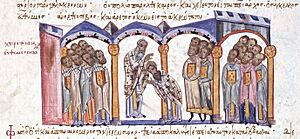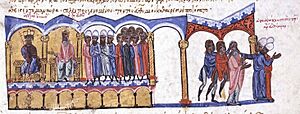Euthymius I of Constantinople facts for kids
Quick facts for kids Euthymius I Syncellus |
|
|---|---|
| Ecumenical Patriarch of Constantinople | |

Consecration of Euthymius as Patriarch of Constantinople. Miniature from the Madrid Skylitzes.
|
|
| Enthroned | 907 |
| Reign ended | 912 |
| Predecessor | Nicholas Mystikos |
| Successor | Nicholas Mystikos |
| Personal details | |
| Born | c. 834 Seleucia in Isauria (modern-day Silifke, Turkey) |
| Died | 5 August 917 "ta Agathou", near Constantinople (modern-day Istanbul, Turkey) |
| Nationality | Byzantine Empire |
Euthymius I Syncellus (born around 834 – died August 5, 917) was a very important church leader in the Byzantine Empire. He served as the Ecumenical Patriarch of Constantinople from 907 to 912. Think of him as the head of the church in the capital city, Constantinople. Euthymius started as a monk when he was young. He later became a spiritual guide for Leo VI the Wise, who would become the emperor. Leo then gave Euthymius a high church job called syncellus. Even though Euthymius and Emperor Leo often disagreed, Euthymius became the Patriarch in 907. He stayed in this powerful role until he was removed from office around the time Leo died in 912.
Contents
Early Life and Becoming a Monk
Euthymius was born in a place called Seleucia in Isauria around the year 834. From a young age, he chose to become a monk. This meant he dedicated his life to religious service. A writer named Arethas of Caesarea said that Euthymius was related to a famous "miracle-worker" named Gregory of Dekapolis.
Euthymius spent time in different monasteries. First, he was at a religious community on Mount Olympus. Then, he moved to a monastery near Nicomedia. Eventually, Euthymius came to Constantinople, which was the capital city of the Byzantine Empire. There, he joined the monastery of St. Theodore, located just outside the city.
Spiritual Guide to an Emperor
Euthymius had a close connection with Patriarch Ignatius, who was the head of the church in Constantinople. It was likely during Ignatius's second time as Patriarch (867–877) that Euthymius became the spiritual guide for Prince Leo. Prince Leo was the son of Emperor Basil I the Macedonian (who ruled from 867–886). This Prince Leo would later become the famous Emperor Leo VI the Wise (who ruled from 886–912).
Some historians believe Euthymius might have been the spiritual guide for all of Emperor Basil's sons. Euthymius supported Leo during a difficult time. Leo had a disagreement with his father, Emperor Basil, because of his relationship with a woman named Zoe Zaoutzaina.
According to a book about Euthymius's life, called the Vita Euthymii, he helped Leo when the prince was imprisoned between 883 and 886. Leo often asked Euthymius for advice. This meant Euthymius had to stay in Constantinople instead of returning to his monastery.
Rise to Power: Abbot and Syncellus
When Emperor Basil I died in 886, Leo became the new emperor. Euthymius was rewarded for his loyalty. He was made the abbot, or head, of a brand-new monastery. This monastery was built in a part of Constantinople called Psamathia. The land for the monastery had been taken from a person named Leo Katakalon, who was sent away from the city.
The Vita Euthymii says that Euthymius only accepted the job after the emperor agreed to let Katakalon return from exile. The emperor also had to give back the rest of Katakalon's property. The new monastery was officially opened on May 6, 889 or 890. Emperor Leo and his brother, Stephen, who was also the Patriarch of Constantinople, were both there.
Around the same time, Euthymius was given another important job: syncellus. He took over this role from Stephen. The syncellus was a high-ranking position in the church. Many people who held this job later became the Patriarch.
Challenges with Emperor Leo
Even though Euthymius was close to Emperor Leo, their relationship was often difficult. This might be why Euthymius didn't become Patriarch until 907. The Vita Euthymii suggests that much of their trouble was caused by Stylianos Zaoutzes, who was Zoe Zaoutzaina's father.
The book describes Stylianos as a very powerful minister who caused many problems. It says Euthymius was constantly battling Stylianos for influence over Emperor Leo. However, some historians question how much power Stylianos truly had. They point out that Emperor Leo seemed to remain in control of his decisions.
Some scholars also see Euthymius as a supporter of the traditional noble families. They believe he disagreed with Leo's advisors who were not from the Byzantine Greek aristocracy. These advisors included Stylianos, an Arab official named Samonas, and Nicholas Mystikos, who was Italian and became Patriarch before Euthymius. However, the Vita Euthymii often makes Euthymius's rivals look bad to make him seem like a perfect saint.
Disagreements Over Marriages
Euthymius first upset Emperor Leo when he supported Leo's first wife, Theophano. He told her not to get a divorce, even though the emperor was neglecting her and still living with Zoe Zaoutzaina. After Theophano died, Euthymius was against Leo's second marriage to Zoe Zaoutzaina. This was because Zoe had a bad reputation. Because of his opposition, Euthymius was confined to a monastery for two years. He was not released until Zoe died.
After Zoe died, Emperor Leo wanted to marry a third time, to Eudokia Baïana. This was usually against church rules. Leo hoped to have a son to inherit his throne. A boy named Basil was born in 901, but Eudokia died during childbirth, and the baby also died soon after. This led to another disagreement between the emperor and Euthymius.
The Vita says that after Zoe and her father died, Leo regretted how he had treated Euthymius. He asked for Euthymius's forgiveness. The emperor often sought Euthymius's advice, even visiting him secretly at his monastery. During one visit, Euthymius predicted Eudokia's death. Later, he refused to go to her funeral. Instead, he left Constantinople with six followers and went to a property owned by his monastery.
The Fourth Marriage and Becoming Patriarch
The emperor then took a mistress, Zoe Karbonopsina. In September 905, they had a son, who would become Emperor Constantine VII Porphyrogennetos. The fact that the child's mother was the emperor's mistress caused problems with church leaders. Emperor Leo had to promise to separate from Zoe before the baby could be baptized. Patriarch Nicholas Mystikos baptized the infant in January 906. Euthymius was also persuaded to be one of Constantine's godfathers at the ceremony.
However, Leo decided he wanted to make Zoe and their son legitimate through a fourth marriage. This was strictly forbidden by church law and could lead to being excommunicated (kicked out of the church). Patriarch Nicholas first supported the emperor, but the church leaders strongly opposed the marriage. This forced Nicholas to change his mind.
Because of this ongoing disagreement, Emperor Leo removed Nicholas from his position as Patriarch in February 907. Euthymius was then appointed as the new Patriarch. The Vita suggests Nicholas was involved in a plot against the emperor, which led to his removal.
Even though Euthymius was known for being stubborn, he was willing to allow the emperor's fourth marriage under certain conditions. Other church leaders from different parts of the empire also agreed. However, Euthymius firmly refused to officially recognize Zoe's marriage to the emperor as fully proper under church law.
Emperor Leo had to do penance (show he was sorry) for his marriage. He also had to pass a law saying that no one could ever marry a fourth time again. As part of this agreement, on May 15, 908, Euthymius crowned the young Constantine VII as co-emperor.
Later Byzantine writers often sided with Nicholas Mystikos against Leo. However, they generally speak well of Euthymius. The Vita says that Euthymius's time as Patriarch helped heal disagreements within the church. It also helped many important church figures accept the emperor's fourth marriage.
Deposition and Death
Shortly before Emperor Leo died in May 912, he made up with Nicholas Mystikos. Nicholas then demanded to be put back in his position as Patriarch. The historical records are not entirely clear. However, soon after Leo's death, or perhaps even before, Euthymius was removed from his position by a church council. Nicholas was then brought back from exile to be the Patriarch again. Euthymius was sent away to Agathou, where he died on August 5, 917.
Writings About Euthymius
A book about Euthymius's life, called the Vita Euthymii (which means The Life of Euthymius), was written around 920–925. The person who wrote it is unknown. However, this author had a very good understanding of what was happening at the emperor's court during Leo VI's reign. Because of this, the Vita Euthymii is one of the most important sources of information for that time period.
The book gives a lively picture of Emperor Leo and his court. It includes stories from people who saw events happen, which helps us understand the emperor's personality. However, the book focuses heavily on Euthymius and is biased in his favor. Also, some parts of the book are missing. The only surviving copy of the manuscript was in Berlin and disappeared during World War II. However, the Vita has been published in several scholarly editions:
- P. Karlin-Hayter (1955–57). "Vita St. Euthymii". Byzantion 25/27: 1–172, 747–778.
Euthymius himself did not write many things. His writings include sermons about the conception of St. Anne and a speech about the Virgin Mary. His contemporary, Arethas of Caesarea, also wrote a speech praising Euthymius. However, this speech is very traditional and doesn't give much new information.
Images for kids



